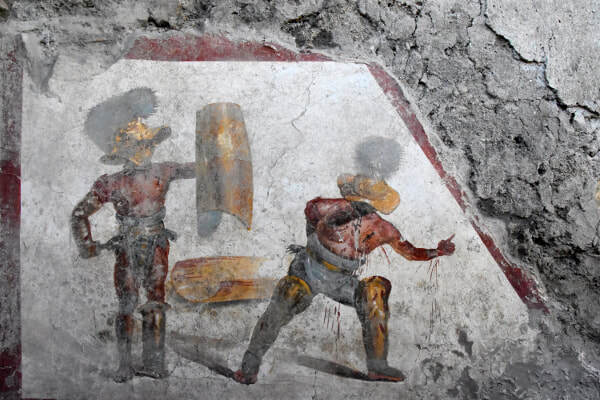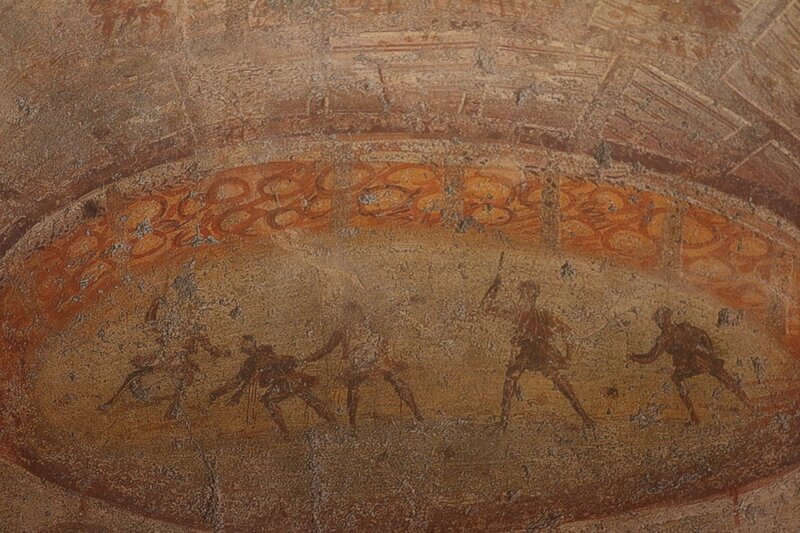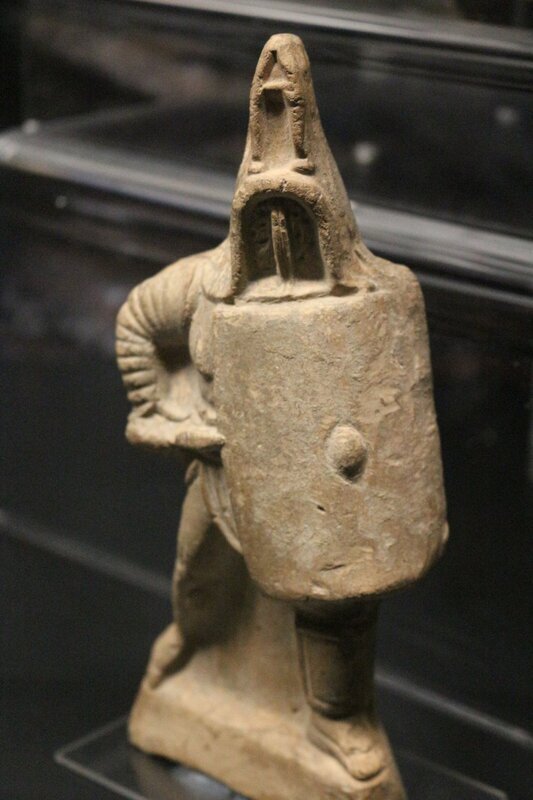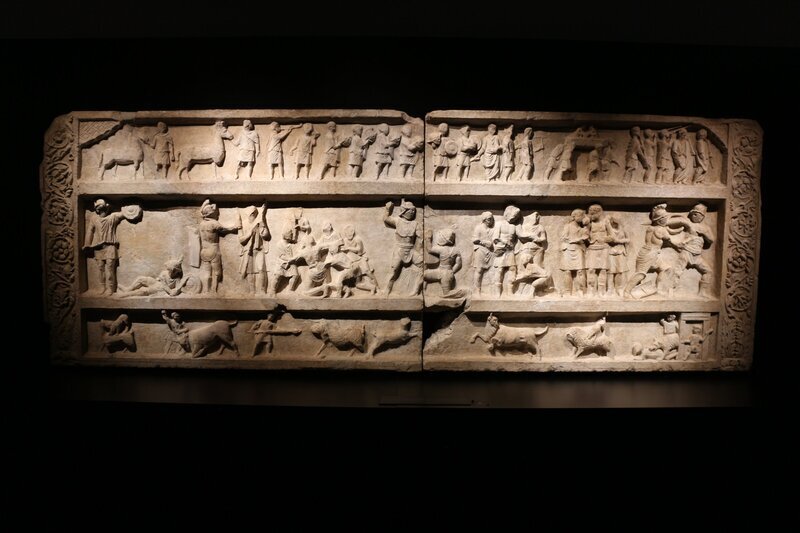The Roman arena is a place that we tend to mythologise, and all sorts of misconceptions can become rooted in 'fact.' One of the newest ones is the idea that gladiators were porky, and on purpose. The idea supposes that because gladiators wore no armour on their torsos, a thicc layer of subcutaneous fat would protect major organs from injury. Even The Simpsons has an episode where Homer fights in an amphitheatre under the name Obeseus. It's become one of those 'facts' that everybody assumes must be true. So, does this theory hold water?
Osteo archaeology
One way of determining what someone may have looked like is to examine skeletal remains. Strong and large muscles leave a mark on the bone, allowing osteo archaeologists to estimate how muscular someone may have been. We have skeletal remains of gladiators from two locations: Roman cemeteries in York and Ephesus. Both cemeteries contained the remains of multiple fighters buried over extended periods of time, and these two groups can be scientifically examined and tested to learn more about their diet and health.
Of the Ephesian gladiators whose skeletons were analysed, muscle markers on the bones indicate that the men’s muscles were ‘significantly enlarged’. Fabian Kanz, who worked on the skeletons, surmised that this was the result of intense physical training over an extended period (2009: 2018). When Kurt Hunter-Mann examined skeletons from York, he came to the same conclusion.
The idea that gladiators were purposefully obese is relatively new, and it can be traced to the Ephesus excavations. One of the paleopathologists gave an interview in a magazine, making a (very generalised) statement based on the results of stable isotope testing on the bones. The tests suggested that most of the Ephesian gladiators had a largely vegetarian diet with large amounts of barley and beans. Recalling a quote from Pliny the Elder that mentions gladiators and barley, the conclusion given in the interview was that gladiators were deliberately fat.
“ "Gladiators needed subcutaneous fat," Grossschmidt explains. "A fat cushion protects you from cut wounds and shields nerves and blood vessels in a fight." Not only would a lean gladiator have been dead meat, he would have made for a bad show. Surface wounds "look more spectacular," says Grossschmidt. "If I get wounded but just in the fatty layer, I can fight on," he adds. "It doesn't hurt much, and it looks great for the spectators." ”
This assertion has remained largely unchallenged but often repeated, making its way into many documentaries and magazine articles, but there are several issues with assuming that gladiators were flabby:
Diet
The gladiators excavated in Ephesus were found within a cemetery that also contained civilians, and isotope analysis revealed that the civilians had practically the same diet as gladiators: a largely vegetarian diet heavily featuring barley and legumes (Lösch et al 2014: 13). The only difference scientists found between gladiators and civilians was that the gladiators had higher strontium levels, which could be attributed to either increased dairy intake or an ash supplement that Pliny mentions gladiators taking to speed up healing. Quoting Marcus Varro, Pliny says “your hearth should be your medicine chest. Drink lye made from its ashes, and you will be cured. One can see how gladiators after a combat are helped by drinking this” (Natural History 36.69). Pliny suggests ash as a cure for a lot of ailments, but there is evidence that this particular drink was indeed beneficial for bone strength. It would not, however, make a gladiator fatter than a civilian. The York gladiators also had a comparable diet to the civilians excavated beside them, though did not show evidence of drinking ash supplements (Müldner et al, 2011: 286).
Pliny’s quote about gladiators being called hordearii, or ‘barley-men’, remarks on the nickname in the past tense in the original latin. Gladiators used to be known as barley-men (Natural History 18.72). Pliny died in 79 CE, and the Ephesian gladiatorial burials mostly date to the second and third centuries CE. Moreover, when Galen, himself a gladiatorial physician in the second century CE, quotes this passage of Pliny in his own work De Alimentorum Facultatibus, or ‘On the Nature of Foodstuffs;’ he elaborates that this was an outdated Athenian nickname for gladiators. This nickname therefore seems to be both regional and old-fashioned by the late first century CE, so it is inappropriate to apply it to gladiators en masse.
Galen writes in ‘On the Nature of Foodstuffs’ that the gladiators he worked with in Pergamon ate a lot of beans. He states that this diet made them ‘fleshy’ (1.19) However, if Galen meant ‘fat’ he could have used the appropriate words he uses elsewhere in his medical texts; the word he uses for obese is ‘polisarkos’ and is not used for gladiators. Instead he clarifies that the gladiatorial body type is not rock hard, but softer and less dense. Gladiators could perhaps pinch an inch, but their rigorous training ensured that they remained mainly muscle. If Galen, a ludus physician who treated these men daily didn’t call gladiators fat, then perhaps neither should we.
If the barley and beans diet was commonly used in ludi across the empire, as it seems to have been in specific locations, then the protein-rich food provided would have indeed been calorific, but was used as fuel for the intense physical activity involved in training. The daily exertions of gladiators meant that they were unlikely to gain thick layers of fat as someone with the same diet and a sedentary lifestyle would.
Weapons
Most gladiators fought with a short sword called a gladius, which was also used by the army. It was primarily a stabbing weapon, the point of which could prove fatal at a mere 5cm of penetration (Bishop 2016: 54). Extra subcutaneous fat, even in the obese, is not going to prevent a fatality from a gladius thrust. Carter has compellingly suggested that most of the time, the point of gladiatorial swords must have been blunted, citing that there are only a few inscriptions, either advertising fights or commemorating them, that describe the swords as having sharpened points, suggesting that this was not the norm and added a heightened layer of drama (Carter 2006). When we consider the nature of gladiatorial combat, this makes a lot of sense:
Legionaries used short swords in a thrusting manner to methodically deliver fatal blows to as many enemies as possible in a short space of time. Gladiatorial fights, however, were one-on-one and designed to be as entertaining as possible for a prolonged length of time: average fights are estimated to have lasted on average between 10-15 minutes (Potter 1999: 314). Blunting the points of swords reduced (but did not eliminate) the probability of fatalities (Carter 2006: 166). Of course, the owners of gladiators were reimbursed for their full worth if they were killed; dead gladiators were incredibly expensive for whoever was staging the show and lowering the odds of death was in their interest as well as the fighters. But did a blunted tip change how gladiators fought, and inspire them to get fat as a form of defence? The gladius could be used in a slicing, slashing motion, but the Romans seemed to consider it a reckless technique. The idea that a few shallow slashes with the long edge of a sword could produce safe spurts of blood to entertain the crowds doesn’t align with how the Romans saw using the sword in that way: Vegetius writes
“The Romans not only easily conquered those who fought with cutting motions, they even ridiculed them for doing so. [...] When a cut is delivered, the right arm and side are exposed, but the stabbing point is delivered with the body protected and wounds the enemy before he sees it. This is what characterises Roman practice with respect to combat.” (Vegetius, Mil. 1.12)
Gladiators wore less armour on the torso than legionaries, so it does not make sense for them to regularly raise their arms to slice, leaving so much of themselves exposed. So if points of swords were usually blunted, how did gladiators fight?
Techniques
We don’t have a surviving ancient manual to reveal the rules of combat, though we know rules existed. What we do know is that gladiatorial bouts were carefully controlled by referees, and that fighters were placed in traditional pairings according to their armature and fighting style, for instance retiarius versus secutor or murmillo versus thraex. Fighters were given their speciality early in their career, and their training would have been specific both to their style and to defending themselves from the style of their normal opponent types. Beyond this, much is a mystery. Junkelmann, having studied gladiatorial arms and armour and artistic depictions, decided that the best way to fill in the gaps in our knowledge was with practical experimentation, and so formed his own modern gladiatorial familia to test out various techniques and theories which he documents in his book Das Spiel mit dem Tod: So kämpften Roms Gladiatoren (2000). The results of years of this experimental archaeology are fascinating.
Firstly, we must forget the cinematic hacks and slashes we’re accustomed to; the swords are too short for the constant clanging we see in movies. Junkelmann’s heavyweight gladiators found that it was their shield, the scutum, that was the primary piece of kit with which to parry a sword. The scutum is a large shield that protected most of the body. Usually, a gladiator’s forward leg would be protected by a greave called an ocrea and their striking arm by an armoured sleeve called a manica. Combined with the helmet, if the scutum was held in the correct position, the gladiator would be almost entirely protected. Slashing blows with a sword would often do little more than produce a loud clang, and such ineffective manoeuvres in heavy gear were too tiring to waste time performing. Not only this, but a hacking slash leaves the side of the attacker’s torso dangerously vulnerable. However, careful thrusts aimed at gaps between sword and armour were more effective, and as we’ve seen, thrusting blows are dangerous at any percentage of body fat. This aligns with Carter’s theory that sword tips were frequently blunted to minimise physical damage to the gladiator’s bodies.
Not all gladiator types were equipped with a scutum. The thraex, or Thracian, and the hoplomachus, loosely based on Greek hoplites, carried a smaller shield called a parmula. However, it does not follow that less protection from a smaller shield might induce their opponents to slash instead of thrust; both the thraex and hoplomachus compensated for their shield size with longer ocreae on both legs. They were also able to capitalise on the greater agility a smaller shield allowed, so these fighters, despite their smaller shields, would have had reason to stay light on their feet and not bulk up. Similarly, the retiarius, or net-fighter, had no shield, no greaves and only a thick padding protection on his non-dominant arm. This was topped with a metal galerus, or shoulder guard, which was the only protection for his bare head. A retiarius, then, was the least defensively armed fighter. He would not want to be large and ungainly; his best defense was to be nimble. He fought against heavily armoured gladiators, usually secutores. ‘Secutor’ means ‘chaser,’ and their name proves that retiarii used speed and agility to their advantage, forcing the secutor to abandon the protection of his defensive stance and go on the offensive, whilst the net-man, armed with a long trident, could keep him at a safe distance. As artistic depictions prove, retiarii did not compensate for their lack of armour with fat, but with lithe bodies built for agility.
None of Junkelmann’s conclusions indicate that a gladiator would have benefitted in any way from a thicker-than-normal layer of subcutaneous fat. A gladiator’s armature was his primary protection, and a second layer of defence, such as obesity, would be superfluous at best and a hindrance at worst. Of course, if a fighter let his guard down or dropped his shield, he left himself vulnerable to a slashing blow. When this happened, the gladius as a chopping sword was simply too effective to reliably produce mild yet ‘theatrical’ injuries, no matter the physique of your opponent. Particularly when we remember that most gladiators wore vision-restricting helmets, defending oneself whilst dealing blows that were deliberately not very serious but looked spectacular would be really difficult to achieve.
Galen, as physician to Pergamene gladiators, witnessed the damage a slashing injury could make first hand, noting that most physicians found these cuts difficult to treat and that they involved long periods of recovery. In one example, a blow to the upper thigh had sliced deep into muscle (Scarborough 2013: 102). Against a gladius, thick subcutaneous fat is simply no substitute for a shield or armour.
Artistic depictions
There are hundreds of ancient images of gladiators. We have mosaics, frescoes, figurines, graffiti, reliefs and piles of terracotta lamps. These works of art are found across the empire and were popular for centuries. Livius.org has catalogued an excellent selection here: https://www.livius.org/tag/gladiator/. There is evidence for some diversity in physiques amongst these fighters; most are broad and heavily muscled, but the level of muscle definition varies. A few, particularly amongst the ‘lightweight’ gladiatorial types such as the retiarii and hoplomachi tend to be more slender. It is rare to find an ancient image of a bulky gladiator. Not all gladiators are depicted as ‘ripped,’ with six packs, but it is hardly appropriate to describe these men as ‘fat.’
Conclusion
The idea that gladiators deliberately ate to bulk up does not align with the evidence that we have for gladiatorial combat. Their diet, unlike bulky Greek contact athletes, does not seem to have included a lot of meat and bread. Instead, it seems that the little archaeological evidence we have supports the literary sources, which together indicate that a gladiator’s diet was largely vegetarian with cheap, humble ingredients and designed to provide the energy needed to train and compete. We also know that gladiatorial training was arduous and highly specialised, it is unlikely that such regular physical exertion allowed these fighters to grow obese on such a diet. Finally, careful experimentation through recreation of actual combat confirms that fights were not frenzied slashing as depicted in movies, a fighting style that would not have impressed Roman fans. Rather, gladiatorial combat was characterised by defensive stances, tactical use of the shield (which movies omit,) and economical, carefully judged thrusts and lunges. Because of this fighting style and the lethality of gladiatorial weapons to any physique, obesity was unlikely to have been a priority. Some gladiators may have naturally carried some extra weight, but it was by no means deliberate, nor the norm. Just because a six pack isn't visible (think: most WWE heavyweights, the front row of a rugby team, etc etc) doesn't mean that an athlete is classified as obese. A healthy layer of fat provides the energy required to endure prolonged periods of hard physical work, meaning that the (modern, Hollywood/social media) concept of the ripped ideal athletic physique is probably unsuited to an ancient professional gladiator, but we simply do not have enough evidence or reason to believe that gladiators were obese on purpose.
Bibliography
D.S. Potter, 'Entertainers in the Roman Empire' in: D.S. Potter & D.J.Mattingly, Life, Death and Entertainment in the Roman Empire (1999) p.256-326
F. Kanz & K .Grossschmidt 'Dying in the Arena: the Osseous Evidence from Ephesian Gladiators' in: T. Wilmott, Roman Amphitheatres and Spectacula, a 21st-Century Perspective (2009) p.211-222
J. Scarborough, 'Galen and the Gladiators,' Episteme, vol.5 (1971), p.98-111; revised with an 'Epilogue' (2013)
M. Carter, 'Gladiatorial Combat with 'Sharp' Weapons' : Zeitschrift für Papyrologie und Epigraphik, vol.155 (2006), p. 161-175
M. Junkelmann, Das Spiel mit dem Tod: So kämpften Roms Gladiatoren (2000)
M.C. Bishop, The Gladius: The Roman Short Sword (2016)
R. Dunkle, Gladiators: Violence and Spectacle in Ancient Rome (2008)





